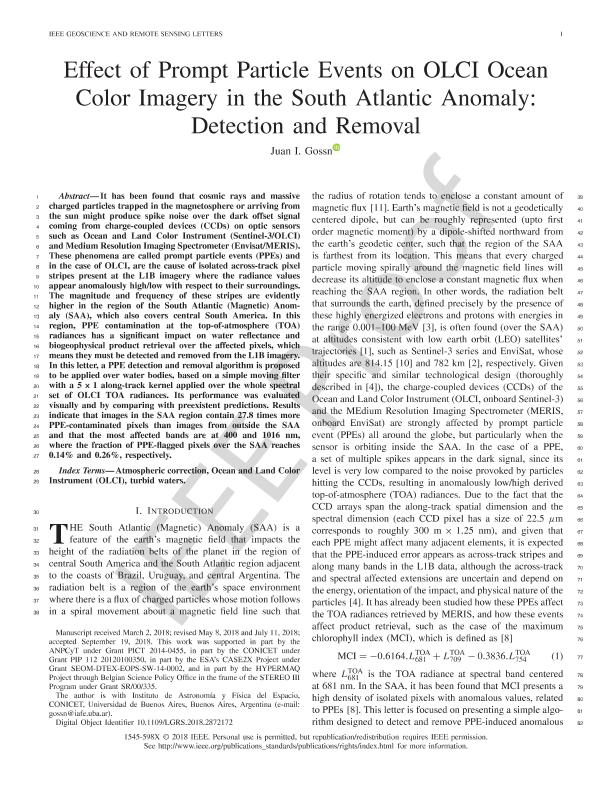Mostrar el registro sencillo del ítem
dc.contributor.author
Gossn, Juan Ignacio

dc.date.available
2019-07-31T15:28:21Z
dc.date.issued
2018-10
dc.identifier.citation
Gossn, Juan Ignacio; Effect of Prompt Particle Events on OLCI Ocean Color Imagery in the South Atlantic Anomaly: Detection and Removal; Institute of Electrical and Electronics Engineers; Ieee Geoscience and Remote Sensing Letters; 16; 2; 10-2018; 163-167
dc.identifier.issn
1545-598X
dc.identifier.uri
http://hdl.handle.net/11336/80671
dc.description.abstract
It has been found that cosmic rays and massive charged particles trapped in the magnetosphere or arriving from the sun might produce spike noise over the dark offset signal coming from charge-coupled devices (CCDs) on optic sensors such as Ocean and Land Color Instrument (Sentinel-3/OLCI) and Medium Resolution Imaging Spectrometer (Envisat/MERIS). These phenomena are called prompt particle events (PPEs) and in the case of OLCI, are the cause of isolated across-track pixel stripes present at the L1B imagery where the radiance values appear anomalously high/low with respect to their surroundings. The magnitude and frequency of these stripes are evidently higher in the region of the South Atlantic (Magnetic) Anomaly (SAA), which also covers central South America. In this region, PPE contamination at the top-of-atmosphere (TOA) radiances has a significant impact on water reflectance and biogeophysical product retrieval over the affected pixels, which means they must be detected and removed from the L1B imagery. In this letter, a PPE detection and removal algorithm is proposed to be applied over water bodies, based on a simple moving filter with a 5 imes 1 along-track kernel applied over the whole spectral set of OLCI TOA radiances. Its performance was evaluated visually and by comparing with preexistent predictions. Results indicate that images in the SAA region contain 27.8 times more PPE-contaminated pixels than images from outside the SAA and that the most affected bands are at 400 and 1016 nm, where the fraction of PPE-flagged pixels over the SAA reaches 0.14% and 0.26%, respectively.
dc.format
application/pdf
dc.language.iso
eng
dc.publisher
Institute of Electrical and Electronics Engineers

dc.rights
info:eu-repo/semantics/openAccess
dc.rights.uri
https://creativecommons.org/licenses/by-nc-sa/2.5/ar/
dc.subject
Atmospheric Correction
dc.subject
Ocean And Land Color Instrument (Olci)
dc.subject
Turbid Waters
dc.title
Effect of Prompt Particle Events on OLCI Ocean Color Imagery in the South Atlantic Anomaly: Detection and Removal
dc.type
info:eu-repo/semantics/article
dc.type
info:ar-repo/semantics/artículo
dc.type
info:eu-repo/semantics/publishedVersion
dc.date.updated
2019-07-29T14:52:14Z
dc.journal.volume
16
dc.journal.number
2
dc.journal.pagination
163-167
dc.journal.pais
Estados Unidos

dc.journal.ciudad
Washington
dc.description.fil
Fil: Gossn, Juan Ignacio. Consejo Nacional de Investigaciónes Científicas y Técnicas. Oficina de Coordinación Administrativa Ciudad Universitaria. Instituto de Astronomía y Física del Espacio. - Universidad de Buenos Aires. Facultad de Ciencias Exactas y Naturales. Instituto de Astronomía y Física del Espacio; Argentina
dc.journal.title
Ieee Geoscience and Remote Sensing Letters

dc.relation.alternativeid
info:eu-repo/semantics/altIdentifier/doi/http://dx.doi.org/10.1109/LGRS.2018.2872172
Archivos asociados
